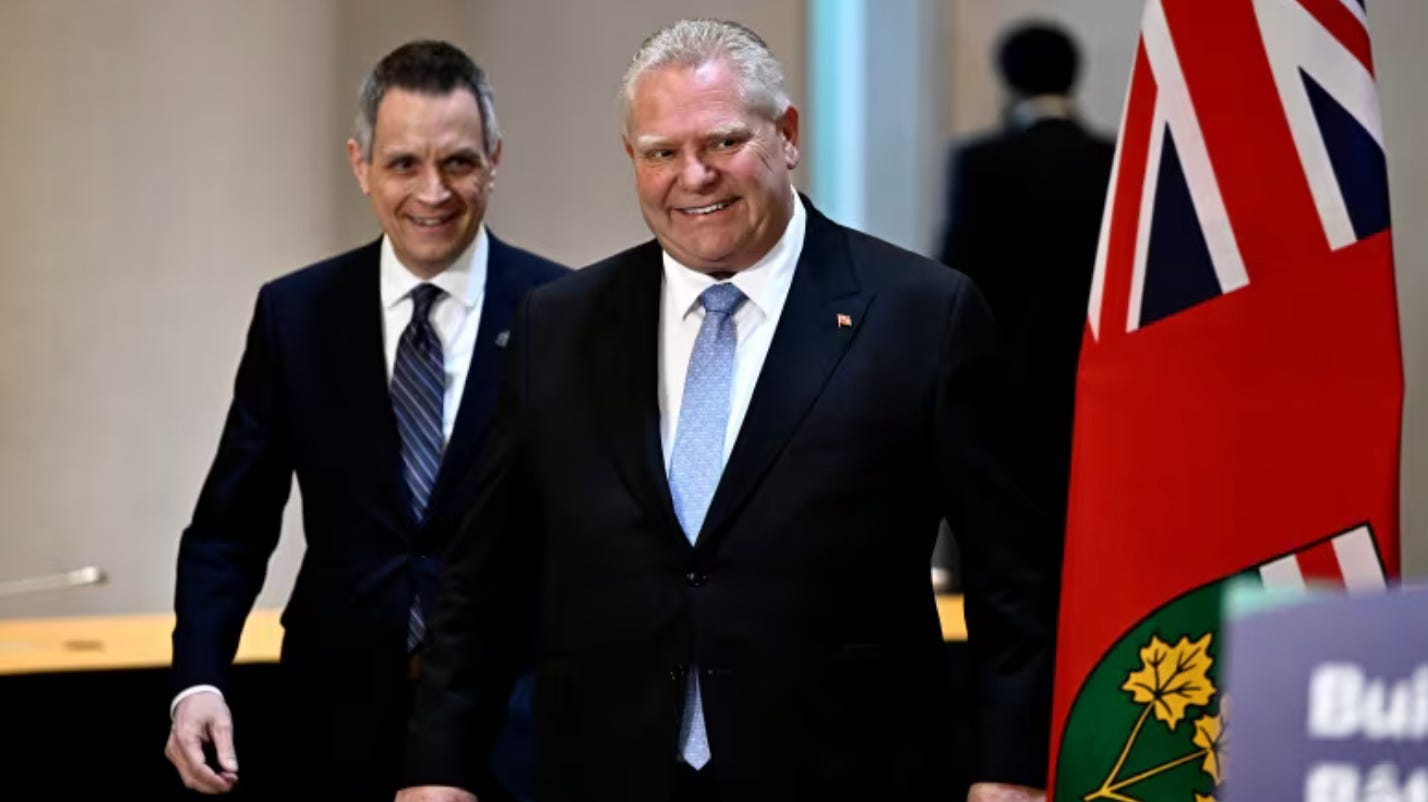New Deal for Ottawa: Was That Really the Best We Could Negotiate?
More money for roads, cops and band-aid solutions for homelessness. But considerably less than Toronto got for its New Deal.
The New Deal for Ottawa, announced by Premier Ford and Mayor Sutcliffe last week, speaks volumes about Mark Sutcliffe’s priorities for the city: roads, cops and band-aid solutions for homelessness.
It’s a stark contrast to the New Deal for Toronto that Mayor Chow negotiated in November. Chow’s deal prioritizes housing and transit.
Chow’s deal is forward-looking, supporting what cities need to do to meet the challenges of our time. Sutcliffe’s deal is driving in the rear view mirror, doubling down on the strategies that have failed us in the past.
A tale of two cities’ negotiations
It’s revealing to compare the New Deals struck by Premier Doug Ford with the cities of Toronto and Ottawa.
Toronto has a population 2.8X that of Ottawa, but negotiated a deal that is 4.7X the size of Ottawa’s deal.
Toronto negotiated a deal amounting to $654 per resident, while Ottawa got $392 per resident.1
That’s a difference of over $250 per head.
The table below lays out the two deals side by side. If you add in the capital cost savings to Toronto of uploading the Gardiner Expressway and Don Valley Parkway, Toronto’s deal is worth an additional $7.6 billion.
Compared to the City of Toronto precedent, Ottawa negotiated a pretty poor deal.
Ottawa should have demanded the same amount per capita as Toronto, but instead came up over $250 million short.
Were Ottawa officials fooled by the Building Faster Fund allocation — forgetting that this had been secured and announced for all Ontario municipalities last year? It is part of the old deal, not the new deal.
And likewise, Ottawa should have demanded the same as Toronto in terms of not counting the cost savings from uploading highways. That is arguably an additional $56 million that we came up short.
Priorities
Toronto
Mayor Chow negotiated a New Deal that supports her top priorities of housing and transit.
Toronto is setting out to build 65,000 non-market rental homes over 7 years. Mayor Chow negotiated that the province contribute surplus land towards these units. Land can be a quarter of the price of a new build, and hence, the value of this free land could be significant for Toronto.
The deal also includes $600 million for emergency shelter support (contingent upon federal matching). How this money will be spent is not clear, but I would expect Toronto to look for long-term solutions to homelessness, i.e., actual housing.
Mayor Chow was strategic to get Ontario to start paying in to the operational costs of transit. Higher levels of government have resisted supporting transit operations — instead steering their money to capital investments only — but Toronto has opened the door to new arrangements.
Premiere Ford was keen to put money into public safety, and for Toronto, this was earmarked for safety on the transit system.
Ottawa
Mayor Sutcliffe’s new deal does little for housing. The deal includes money for addressing emergency shelter support (contingent upon federal matching) but indications are that the City will allocate this to tents and other band-aid solutions. There is no sign that the City is planning to find permanent solutions; i.e. actually housing the homeless.
On transportation, Sutcliffe’s deal is focused on a new Barrhaven highway interchange and rural roads. There is also some money for connecting Kanata Bus Rapid Transit to the LRT, however, it is unclear how much will be allocated for public transit.
Ford was vocal that he is not willing to support transit operations. That’s strange, because supporting transit operations is exactly what he did for Toronto. Regardless, it’s evident that the City of Ottawa was not asking for more operational funding for transit.
On public safety, Ottawa has seemingly put the bulk of money into a new ByWard Market police station. It is unclear whether this is a new station, or simply money for more police officers stationed in the Rideau Centre.
Some of the public safety money is being allocated to transit and non-police response to lower-risk calls. But how the $48 million is allocated between these three items has not been identified.
Where’s Lansdowne?
Missing from the announcement was the $20 million that, back in November, Sutcliffe asked the Premier to contribute to the Lansdowne 2.0 redevelopment.
Who knows what happened here?
Maybe, Ford’s political antenna were sharp enough to stay clear of a project which many see as little more than corporate welfare.
Or maybe, Lansdowne is really just not that important a priority for the city.
Which begs the question, why is the City of Ottawa spending half a billion dollars to tear down and rebuild a perfectly good sports stadium?
I have removed the potential $118m to Ottawa from the Building Faster Fund, since this was announced last year and is money Ottawa could access regardless of this New Deal. Toronto is set to receive an additional $300-400 million from this Fund that is not included in the table.







Toronto elects a progressive mayor and gets provincial money for progressive priorities. Ottawa elects...the guy we elected, and gets provincial money for suburban roads.
Funny how that works out.